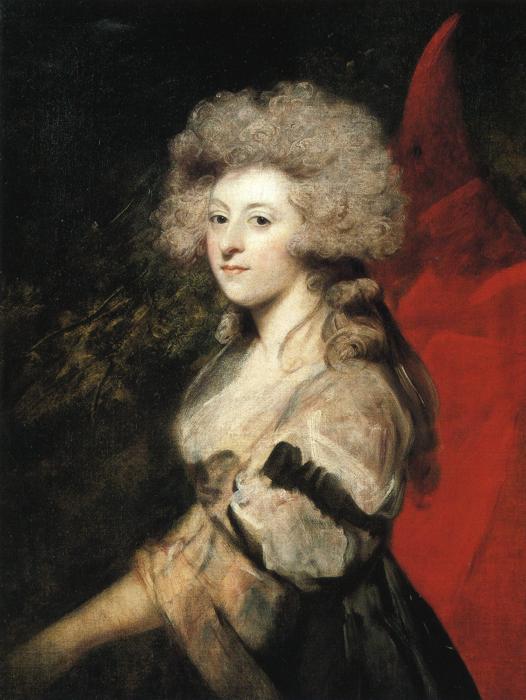by Susan Flantzer © Unofficial Royalty 2015

King George IV of the United Kingdom; Credit – Wikipedia
King George IV, the eldest child of the fifteen children of King George III of the United Kingdom and Charlotte of Mecklenburg-Strelitz, was born at St James’ Palace in London, England on August 12, 1762. George’s birth marked the first time an heir had been born to a reigning monarch since the birth of King James II’s son in 1688. At birth, George was automatically Duke of Cornwall as the eldest son of the reigning monarch. Five days after his birth, George was created Prince of Wales. He was christened at St James’s Palace by Thomas Secker, Archbishop of Canterbury, and given the names George Augustus Frederick. His godparents were:
- Adolf Friedrich IV, Duke of Mecklenburg-Strelitz (his maternal uncle)
- Prince William, Duke of Cumberland (his paternal great-uncle)
- Dowager Princess of Wales (his paternal grandmother Augusta)

George (left) with his mother Queen Charlotte and younger brother Frederick, painted by Allan Ramsay in 1764; Credit – Wikipedia
George had fifteen siblings and he was 21 years older than his youngest sibling, Princess Amelia.
- Prince Frederick, Duke of York (1763 – 1827), married Frederica of Prussia, no issue
- King William IV (1765 – 1837), married Adelaide of Saxe-Meiningen, no surviving legitimate issue, has illegitimate descendants
- Charlotte, Princess Royal (1766 – 1828), married King Friedrich I of Württemberg, no surviving issue
- Prince Edward, Duke of Kent (1767 – 1820), married Victoria of Saxe-Coburg-Saalfeld, had issue: Queen Victoria, present British Royal Family are his descendants
- Princess Augusta Sophia (1768 – 1840), never married, no issue
- Princess Elizabeth (1770 – 1840), married Friedrich, Landgrave of Hesse-Homburg, no issue
- King Ernest Augustus I of Hanover, Duke of Cumberland (1771 – 1851), married Friederike of Mecklenburg-Strelitz; had issue
- Prince Augustus Frederick, Duke of Sussex (1773 – 1843), married twice, both in contravention of the Royal Marriages Act of 1772 1) Lady Augusta Murray, had issue, marriage annulled 2) Lady Cecilia Buggin (later 1st Duchess of Inverness), no issue
- Prince Adolphus, Duke of Cambridge (1774 – 1850), married Augusta of Hesse-Kassel, had issue, present British Royal Family are his descendants through his granddaughter Mary of Teck who married King George V of the United Kingdom
- Princess Mary (1776 – 1857), married Prince William Frederick, Duke of Gloucester, no issue
- Princess Sophia (1777 – 1848), never married, possible illegitimate issue
- Prince Octavius (1779 – 1783), died in childhood
- Prince Alfred (1780 – 1782), died in childhood
- Princess Amelia (1783 – 1810), never married, no issue

Queen Charlotte painted by Benjamin West in 1779 with her 13 eldest children; Credit – http://www.royalcollection.org.uk
George was created a Knight of the Garter at age three and was introduced to ceremonial functions at an early age. He was brought up and educated with his brother Prince Frederick at Kew Palace. Robert Darcy, 4th Earl of Holderness was their governor, and William Markham, Bishop of Chester was their chief tutor. After Markham became Archbishop of York, Richard Hurd, Bishop of Worcester became the princes’ chief tutor. The young princes spent eight hours a day with their tutors and learned to ride and fence.
Even as a young child, George irritated his father, starting another occurrence of Hanover heirs not getting along with their fathers. When he was a teenager, George increasingly rebelled against his parents. He became associated with prominent Whigs such as Charles James Fox, who were in opposition to the Conservative government of King George III. These Whig circles also promoted George’s gambling, his tendency to womanizing, and his extravagant lifestyle. Even before he came of age, George attracted the attention of London society by having an affair with Mary Robinson, actress, poet, dramatist, and novelist. Mary had gained fame portraying Perdita in Shakespeare’s The Winter Tale and was nicknamed Perdita. George was then nicknamed Florizel, Perdita’s love interest in the play. Caricatures and satires of the couple as Perdita and Florizel were popular at the time.

Caricature of the Prince of Wales as Florizel and Mary Robinson as Perdita, 1783; Credit – Wikipedia
Upon his 21st birthday in 1783, George became of age and received a grant from Parliament of £60,000 to pay his debts (£6,451,000 today) and an annual income of £50,000 (£5,376,000 today) from his father. To evade the strict lifestyle of his parents, George set up his own household at Carlton House, a residence on the Pall Mall in London. George’s lavish redecoration of Carlton House once again put him in debt and once again, Parliament and his father bailed him out.

Prince of Wales, Miniature by Richard Cosway, 1792; Credit – Wikipedia
In 1784, George fell in love with Maria Fitzherbert, a twice-widowed Catholic Irish woman. A marriage with a Catholic would mean that George would lose his place in the succession as stipulated by the Act of Settlement 1701. In addition, the Royal Marriages Act 1772, prohibited the marriage without the consent of the King, which would never have been granted. Nevertheless, the couple went through with a legally void marriage at Maria Fitzherbert’s home on December 21, 1785. Maria Fitzherbert was convinced she was the lawful wife of the Prince of Wales as she viewed church law to be superior to the law of the state. For political reasons, the marriage remained secret, although there were rumors spreading all over London, and Maria Fitzherbert had promised to not let anything about it be announced in public.

Maria Fitzherbert; Credit – Wikipedia
By 1794, George was again severely in debt. If he married, Parliament would settle his debts and his allowance would be increased by £ 100,000. On June 23, 1794, Maria Fitzherbert was informed by letter that her relationship with the Prince of Wales was over. Caroline of Brunswick, his first cousin, was selected as the bride. Her father Karl Wilhelm Ferdinand, Duke of Brunswick-Wolfenbüttel, was a favorite nephew of Frederick the Great, King of Prussia, and had distinguished himself as a commander in the Seven Years’ War. Britain was at war with revolutionary France and eager to obtain allies on the European mainland. Caroline’s mother Augusta was a sister of George III. Caroline and George were married on April 8, 1795, at the Chapel Royal, St. James’ Palace, in London.

George and Caroline’s wedding; Credit – Wikipedia
This marriage is one of the worst ever royal marriages. Upon first seeing Caroline, George said to his valet, “Harris, I am not well. Pray get me a glass of brandy.” Caroline said George was fat and not as handsome as his portrait. It is doubtful that the couple spent more than a few nights together as husband and wife. Their only child, Princess Charlotte of Wales, was born nine months later. They found each other equally unattractive and never lived together nor appeared in public together. Caroline was prevented from seeing her daughter. Their daughter Charlotte married Leopold of Saxe-Coburg-Saalfeld (the uncle of Queen Victoria and Prince Albert and the future King of the Belgians), but she predeceased both her parents, dying in childbirth in 1817 at the age of 21, along with her son. Had Charlotte lived, she would have succeeded her father on the throne.
Caroline eventually went to live abroad where she ran up debts and had lovers. She returned to England when George became king and he promptly started divorce proceedings. However, a parliamentary bill dissolving the marriage and stripping Caroline of her title of Queen failed. Caroline was turned away from Westminster Abbey during her husband’s coronation in 1821. She died a few weeks later and her remains were shipped back to her native Brunswick where she was buried at Brunswick Cathedral. The inscription on her tomb reads, “Here lies Caroline, the Injured Queen of England.”
During the reign of King George III, he suffered attacks of illness and there has been speculation that he suffered from porphyria. The American Revolutionary War and the loss of the American colonies was a great blow to George III and in 1788, he suffered another attack. This attack was more serious and George III was terribly deranged for a period of six months. At this time, Parliament had introduced a Regency Bill which made the Prince of Wales the Regent, but before it could be passed King George III recovered.
By 1805, King George III was almost completely blind. On October 25, 1809, a golden jubilee for the 50th year of his reign was held. Princess Amelia, George III’s youngest child, died on November 10, 1810, and this hastened his final decline. George III became so ill that it was necessary for Parliament to pass the Regency Act of 1811. The Prince of Wales acted as Regent until his father died in 1820 and was known as The Prince Regent. Queen Charlotte was her husband’s legal guardian, but could not bring herself to visit him due to his violent outbursts and erratic behavior.
Upon the death of King George III on January 29, 1820, The Prince Regent succeeded to the throne as King George IV. At the time of his succession, George IV was obese and probably addicted to laudanum. His coronation, on July 19, 1821, despite being expensive and lavish, was popular with the British people.

King George IV’s coronation; Credit – Wikipedia

King George IV in his coronation robes; Credit – Wikipedia
George IV was the first British monarch to visit Ireland (in August 1821) since the reign of King Richard II in the 14th century and the first British Hanover monarch (the British Hanover kings were also Kings of Hanover) to visit Hanover (in September 1821) in 66 years. His 21-day visit to Scotland in 1822, organized by author Sir Walter Scott, was the first by a British monarch since the reign of King Charles II. On his trip to Scotland, George IV frequently wore a kilt and this helped to make the traditional garb of Highland Scotland popular during the 19th century.

King George IV during his 1822 trip to Scotland; Credit – Wikipedia
The trip to Scotland was the last major trip that George IV took. After that, suffering from gout, arteriosclerosis, edema, and possibly porphyria, he spent more and more time in seclusion at Windsor Castle. Because of his excessive lifestyle, he had become so fat (his weight in 1830 was 130 kg/280 lbs) that he increasingly was an object of ridicule when he appeared in public. George IV’s final illness began in January 1830 with a severe cough. He improved slightly in March 1830 but continued to have respiratory problems, faintness, and urinary tract pain. King George IV died at the age of 67 on June 26, 1830, at Windsor Castle and the throne passed to the next surviving son of King George III, Prince William, Duke of Clarence who reigned as King William IV. George IV was buried in the Royal Tomb House at St. George’s Chapel, Windsor Castle.

Lithograph of George IV in profile, by George Atkinson, printed by C. Hullmandel, 1821; Credit – Wikipedia
This article is the intellectual property of Unofficial Royalty and is NOT TO BE COPIED, EDITED, OR POSTED IN ANY FORM ON ANOTHER WEBSITE under any circumstances. It is permissible to use a link that directs to Unofficial Royalty.
House of Hanover Resources at Unofficial Royalty
